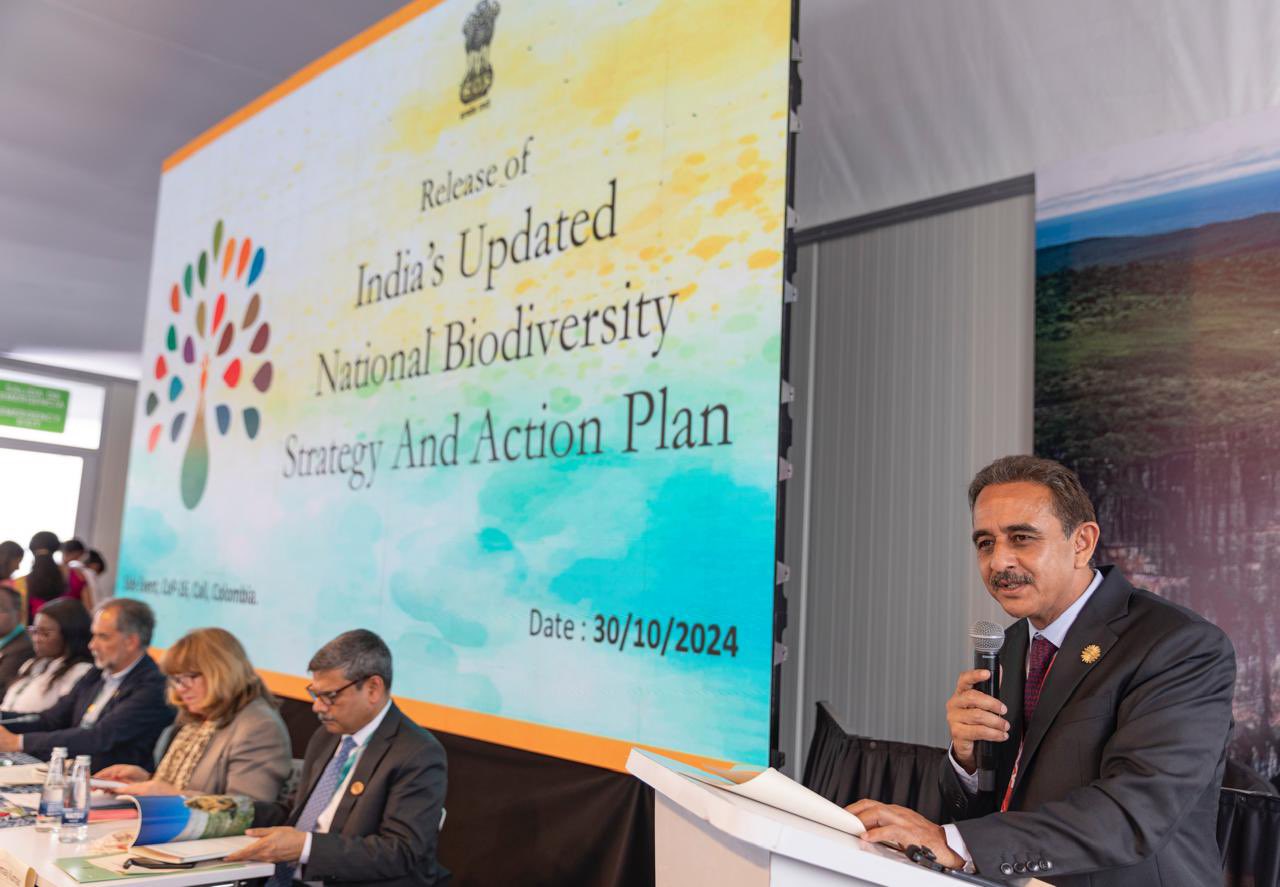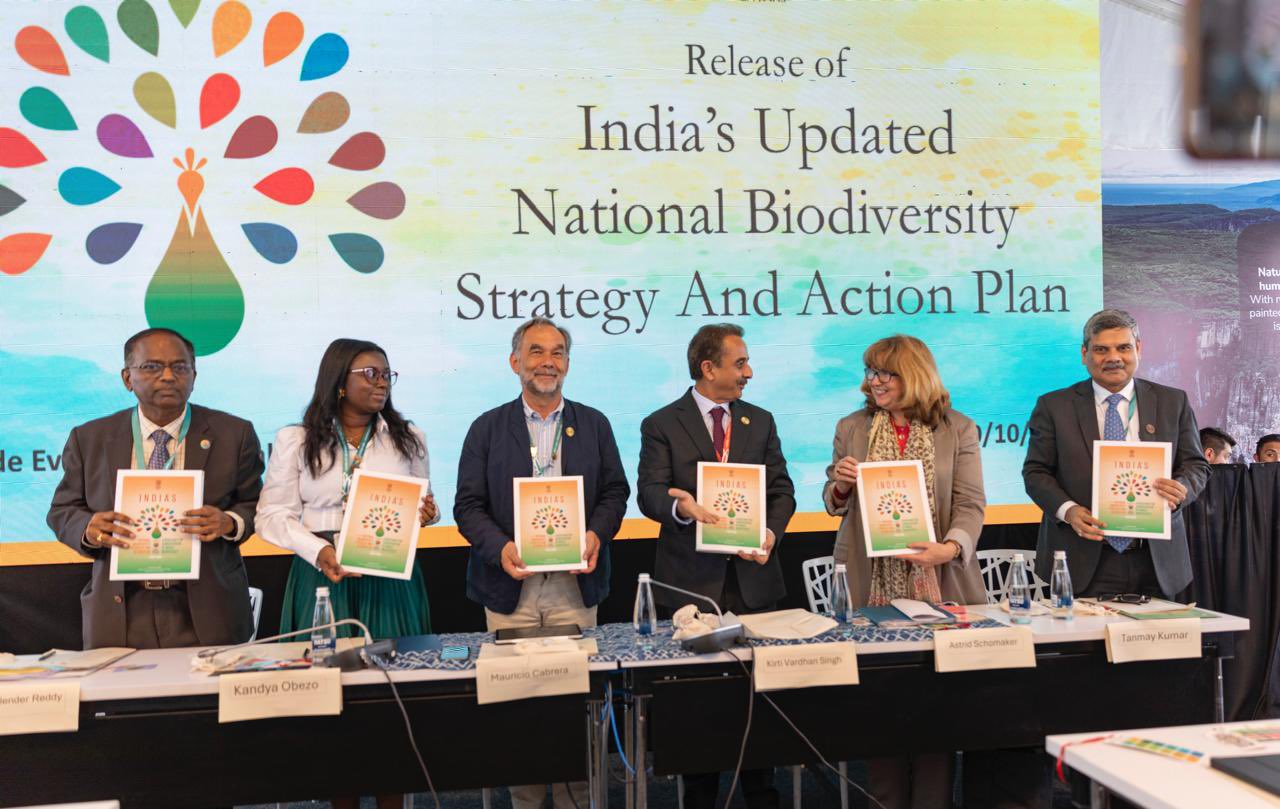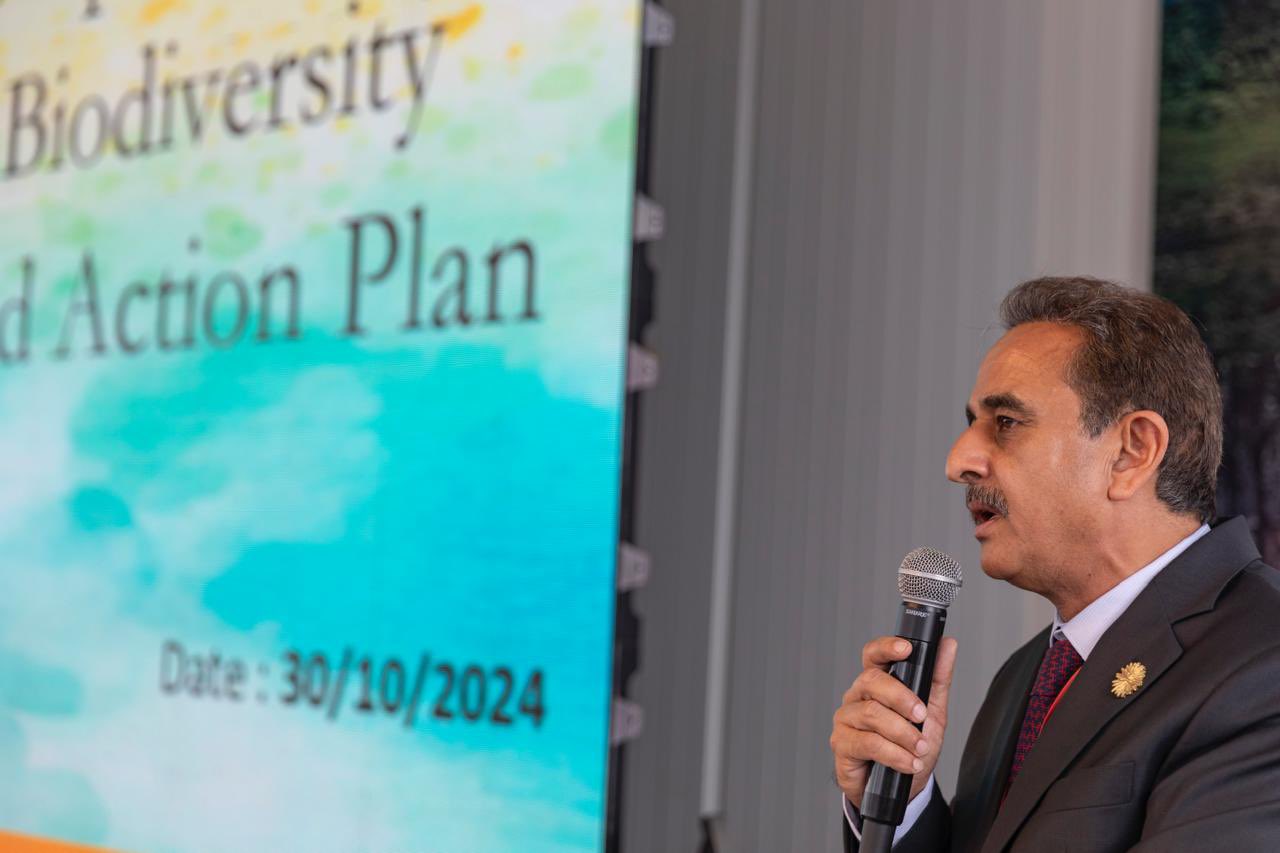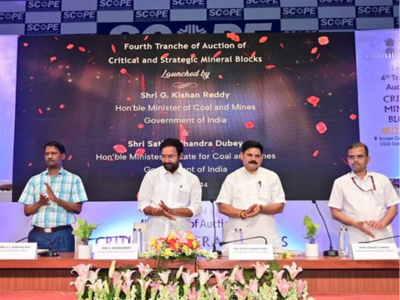Table of Contents
ToggleIndia Unveils Updated National Biodiversity Strategy and Action Plan at COP 16 in Colombia
Union Minister of State for Environment, Forest and Climate Change, Shri Kirti Vardhan Singh, unveiled India’s updated National Biodiversity Strategy and Action Plan (NBSAP) at the 16th Conference of Parties (COP 16) to the Convention on Biological Diversity (CBD). The document was presented during a special event titled ‘Roadmap for achieving the Kunming-Montreal Global Biodiversity Framework (KMGBF) targets and release of India’s updated NBSAP’ on October 30, 2024, in Cali, Colombia.
Released India’s updated National Biodiversity Strategies and Action Plan (NBSAP) today. India has adopted a ‘Whole of Government’ and ‘Whole of Society’ approach while updating its NBSAP and its targets are aligned with the KMGBF. India has already submitted its National… pic.twitter.com/WFMvCc1HZx
— Kirti Vardhan Singh (@KVSinghMPGonda) October 31, 2024
The event saw the distinguished presence of Mauricio Cabrera, Vice-Minister of Environment and Sustainable Development, Colombia; Ms. Kandya Obezo, Vice-Minister of Multilateral Affairs, Colombia; Ms. Astrid Schomaker, Executive Secretary, CBD; Shri Tanmay Kumar, Special Secretary, Ministry of Environment, Forest and Climate Change, Government of India; and Shri C. Achalender Reddy, Chairman, National Biodiversity Authority.
During the event, Shri Kirti Vardhan Singh emphasized that the updated NBSAP, aligned with the KMGBF, serves as a vital roadmap to halt and reverse biodiversity loss by 2030, with a longer-term vision of living in harmony with nature by 2050. He highlighted India’s adoption of a ‘Whole-of-Government’ and ‘Whole-of-Society’ approach in updating its NBSAP.
The Minister further noted that the updated NBSAP acknowledges environmental challenges and outlines strategies to address them through ecosystem restoration, species recovery programs, and community-driven conservation efforts, focusing on the restoration of degraded ecosystems, protection of wetlands, and sustainable management of marine and coastal areas.
Special Secretary, MoEFCC, emphasized India’s governance framework for biodiversity conservation, exemplified by the Biological Diversity Act of 2002 and its amendments in 2023. This framework includes a three-tier institutional structure comprising the National Biodiversity Authority, State Biodiversity Boards, and local Biodiversity Management Committees, ensuring effective implementation at all levels.
The MoEFCC serves as the central agency responsible for coordinating biodiversity conservation efforts across India. The NBSAP update was driven by an extensive consultative process, led by MoEFCC and involving 23 central Ministries, multiple Departments, State-level organizations, communities, and other stakeholders. The updated NBSAP aligns with the Kunming-Montreal Global Biodiversity Framework, setting 23 national biodiversity targets through an extensive consultative process involving diverse stakeholders.
It was further informed that India’s updated National Biodiversity Strategy and Action Plan (NBSAP) had been prepared under the able and constant guidance of Shri Bhupender Yadav, Union Minister for Environment, Forest and Climate Change, and Ms. Leena Nandan, Secretary, MoEFCC.
The updated NBSAP emphasizes a transformative approach, focusing on ecosystem-based management, a bottom-up approach for implementation, mainstreaming biodiversity, sectoral integration, and inter-agency cooperation. It also provides insights into the current status of biodiversity across India, existing policy and institutional frameworks, biodiversity expenditure, and potential biodiversity finance solutions.

Key Objectives of the Updated National Biodiversity Strategy and Action Plan (NBSAP)
India’s updated National Biodiversity Strategy and Action Plan (NBSAP) sets forth several key objectives aimed at halting and reversing biodiversity loss by 2030, with a longer-term vision of living in harmony with nature by 2050. Here are the primary objectives:
1. Biodiversity-Inclusive Planning for Land and Sea Use
The updated National Biodiversity Strategy and Action Plan (NBSAP) emphasizes the need for biodiversity-inclusive planning in land and sea use. This involves implementing effective management processes to ensure that the loss of highly biodiverse areas is minimized. The plan aims to use high-resolution geospatial data to identify and protect rich, biodiverse areas and endangered ecosystems.
2. Ecosystem Restoration
A major focus of the updated National Biodiversity Strategy and Action Plan (NBSAP) is the restoration of degraded ecosystems. The plan sets a target to ensure that by 2030, at least 30% of degraded terrestrial, inland water, and marine and coastal ecosystems are under effective restoration. This restoration aims to enhance biodiversity, ecosystem functions, services, ecological integrity, and connectivity.
3. Protection and Conservation of Land and Sea Areas
The National Biodiversity Strategy and Action Plan (NBSAP) outlines strategies to protect and conserve land and sea areas with high ecological integrity. This includes the sustainable management of marine and coastal areas, the protection of wetlands, and the implementation of integrated coastal management policies.
4. Management of Species and Genetic Diversity
The updated NBSAP focuses on the management of species and genetic diversity. This includes species recovery programs, conservation of genetic resources, and measures to prevent the over-exploitation of wild species.
5. Addressing Invasive Alien Species
The plan includes strategies to manage and reduce the impact of invasive alien species on native biodiversity. This involves monitoring, controlling, and eradicating invasive species to protect native ecosystems.
6. Reducing Pollution Risks
The National Biodiversity Strategy and Action Plan (NBSAP) aims to reduce pollution risks and their negative impact on biodiversity. This includes measures to control pollution from various sources, such as industrial activities, agriculture, and urbanization.
7. Climate Change Mitigation and Adaptation
The updated NBSAP recognizes the impact of climate change on biodiversity and includes strategies for climate change mitigation and adaptation. This involves enhancing the resilience of ecosystems and species to climate change and integrating biodiversity considerations into climate policies.
8. Community-Driven Conservation Efforts
The NBSAP emphasizes the importance of community-driven conservation efforts. This includes engaging local communities in biodiversity conservation, promoting sustainable livelihoods, and ensuring that conservation efforts respect the rights and knowledge of indigenous and local communities.
9. Mainstreaming Biodiversity
The plan aims to mainstream biodiversity across various sectors, including agriculture, forestry, fisheries, and urban planning. This involves integrating biodiversity considerations into sectoral policies and practices to ensure sustainable development.
10. Enhancing Biodiversity Finance
The updated National Biodiversity Strategy and Action Plan (NBSAP) outlines strategies to enhance biodiversity finance. This includes identifying and mobilizing financial resources for biodiversity conservation, promoting innovative financing mechanisms, and ensuring that biodiversity funding is effectively utilized.

Challenges and Solutions in Implementing the Updated NBSAP
Challenges
Habitat Loss and Degradation
Challenge: One of the most significant challenges is the ongoing loss and degradation of habitats due to urbanization, industrialization, and agricultural expansion. This leads to the fragmentation of ecosystems and loss of biodiversity.
Solution: The updated National Biodiversity Strategy and Action Plan (NBSAP) emphasizes ecosystem restoration and the protection of critical habitats. Implementing effective land-use planning and promoting sustainable agricultural practices can help mitigate habitat loss.
Climate Change
Challenge: Climate change poses a severe threat to biodiversity, affecting species distribution, ecosystem functions, and the availability of resources.
Solution: The National Biodiversity Strategy and Action Plan (NBSAP) includes strategies for climate change mitigation and adaptation. Enhancing the resilience of ecosystems and integrating biodiversity considerations into climate policies are crucial steps to address this challenge.
Invasive Alien Species
Challenge: Invasive alien species can outcompete native species, disrupt ecosystems, and lead to biodiversity loss.
Solution: The updated National Biodiversity Strategy and Action Plan (NBSAP) outlines measures to monitor, control, and eradicate invasive species. Public awareness campaigns and community involvement are essential to prevent the introduction and spread of invasive species.
Pollution
Challenge: Pollution from industrial activities, agriculture, and urbanization negatively impacts biodiversity and ecosystem health.
Solution: The National Biodiversity Strategy and Action Plan (NBSAP) aims to reduce pollution risks through stricter regulations, promoting cleaner production technologies, and encouraging sustainable waste management practices.
Limited Financial Resources
Challenge: Securing adequate financial resources for biodiversity conservation remains a significant challenge.
Solution: The updated National Biodiversity Strategy and Action Plan (NBSAP) emphasizes enhancing biodiversity finance through innovative financing mechanisms, public-private partnerships, and international funding. Efficient utilization of available resources is also crucial.
Lack of Public Awareness and Engagement
Challenge: Limited public awareness and engagement in biodiversity conservation can hinder the implementation of conservation initiatives.
Solution: The National Biodiversity Strategy and Action Plan (NBSAP) includes strategies to raise public awareness and education about the importance of biodiversity. Community-driven conservation efforts and involving local communities in decision-making processes are vital for success.
Coordination Among Stakeholders
Challenge: Effective coordination among various stakeholders, including government agencies, NGOs, local communities, and the private sector, is essential but often challenging.
Solution: The National Biodiversity Strategy and Action Plan (NBSAP) promotes a ‘Whole-of-Government’ and ‘Whole-of-Society’ approach, ensuring that all relevant stakeholders are involved in the planning and implementation of biodiversity conservation efforts. Regular communication and collaboration are key to overcoming this challenge.
Solutions
Ecosystem-Based Management
Solution: Adopting an ecosystem-based management approach ensures that conservation efforts are holistic and consider the interconnections between different ecosystem components. This approach helps maintain ecosystem integrity and resilience.
Community-Driven Conservation
Solution: Engaging local communities in conservation efforts ensures that initiatives are culturally appropriate and sustainable. Community-driven conservation projects, such as the restoration of degraded ecosystems and the protection of wetlands, are highlighted in the updated National Biodiversity Strategy and Action Plan (NBSAP).
Mainstreaming Biodiversity
Solution: Integrating biodiversity considerations into sectoral policies and practices, such as agriculture, forestry, fisheries, and urban planning, ensures that biodiversity is protected across various sectors. This approach promotes sustainable development and reduces the impact on biodiversity.
Innovative Financing Mechanisms
Solution: Exploring innovative financing mechanisms, such as biodiversity offsets, green bonds, and payment for ecosystem services, can help secure additional financial resources for biodiversity conservation. Public-private partnerships and international funding are also crucial.
Technological Advancements
Solution: Leveraging technological advancements, such as remote sensing, GIS mapping, and data analytics, can enhance biodiversity monitoring and management. These tools provide valuable insights for effective decision-making and conservation planning.

Role of Technology in National Biodiversity Conservation
In the context of India’s updated National Biodiversity Strategy and Action Plan (NBSAP), technology plays a crucial role in enhancing biodiversity conservation efforts. Here are some key technological advancements and their applications in biodiversity conservation:
Remote Sensing and Satellite Imagery
Remote sensing and satellite imagery are powerful tools for monitoring changes in land use, deforestation rates, and habitat conditions. Technologies like Landsat satellites provide detailed images that help scientists track environmental changes over time. This aerial perspective allows for comprehensive analysis of ecosystems without invasive on-the-ground assessments. By utilizing these technologies, conservationists can identify vulnerable habitats and implement timely interventions to protect them.
Geographic Information Systems (GIS)
Geographic Information Systems (GIS) are computer-based tools used to store, visualize, analyze, and interpret geographic data. GIS mapping technology plays a crucial role in making informed decisions about wildlife protection and habitat management. It enables conservationists to accurately observe wildlife populations, monitor illegal activities, and detect changes in the landscape. GIS helps in creating detailed maps that highlight critical biodiversity areas, aiding in effective conservation planning.
Artificial Intelligence and Data Analytics
Artificial Intelligence (AI) and data analytics are revolutionizing how ecological data is processed and analyzed. Machine learning algorithms can sift through vast amounts of information gathered from various sources, such as camera traps and acoustic sensors, to identify species presence or detect changes in animal behavior. Predictive analytics can help conservationists model potential outcomes based on different scenarios, enabling informed decision-making about resource allocation and conservation strategies.
Drones for Monitoring and Enforcement
Drones equipped with high-resolution cameras and thermal imaging capabilities have emerged as invaluable tools for wildlife monitoring and anti-poaching efforts. They can cover large areas quickly while providing real-time data on wildlife populations and illegal activities within protected areas. Drones facilitate surveillance operations by detecting poachers before they reach their targets, empowering rangers with crucial information to safeguard endangered wildlife effectively.
Environmental DNA (eDNA) and Genomics
Environmental DNA (eDNA) technology allows conservationists to collect a wealth of biodata quickly and easily from soil and water samples. Traces of animal DNA can reveal the presence of previously unobserved species. This non-invasive method helps detect both native and invasive species more effectively than traditional sampling. Genomics can provide insights into the genetic diversity of species, aiding in the development of targeted conservation strategies.
Citizen Science Platforms
Technology empowers everyday citizens to contribute to biodiversity conservation through citizen science platforms. Apps like iNaturalist enable users to document flora and fauna sightings using their smartphones while contributing valuable data to scientific research efforts globally. This collective effort enhances biodiversity databases and supports large-scale conservation initiatives.
Real-Time Monitoring Systems
Real-time monitoring systems, such as camera traps and acoustic sensors, provide continuous data on wildlife behavior and habitat conditions. These systems enable conservationists to respond promptly to emerging threats and make data-driven decisions. Real-time monitoring is particularly useful in remote or inaccessible areas where traditional monitoring methods are challenging.
Digital Transformation and Data Sharing
Digital transformation offers unprecedented opportunities to gather, analyze, and disseminate crucial information for biodiversity conservation. By harnessing the power of technology, conservationists can better comprehend the intricate relationships between ecosystems and species. Data sharing platforms facilitate collaboration among researchers, policymakers, and conservation organizations, promoting a unified approach to biodiversity conservation.
Public Awareness and Education in the Context of National Biodiversity
Public awareness and education are critical components of India’s updated National Biodiversity Strategy and Action Plan (NBSAP). These efforts aim to foster a deeper understanding of biodiversity’s importance and encourage active participation in conservation initiatives. Here are the key aspects of public awareness and education in the context of national biodiversity:
Raising Awareness about Biodiversity
Campaigns and Outreach Programs: The National Biodiversity Strategy and Action Plan (NBSAP) includes various campaigns and outreach programs designed to educate the public about the significance of biodiversity. These initiatives aim to highlight the ecological, economic, and cultural value of biodiversity and the need for its conservation.
Media Engagement: Utilizing traditional and digital media platforms to disseminate information about biodiversity conservation. This includes television, radio, newspapers, social media, and online portals to reach a broad audience.
Community Events: Organizing community events such as biodiversity fairs, exhibitions, and nature walks to engage local communities and raise awareness about the importance of protecting biodiversity.
Educational Programs and Curriculum Integration
School and College Programs: Integrating biodiversity education into school and college curricula to instill a sense of responsibility and awareness among students from a young age. This includes classroom lessons, field trips, and hands-on activities related to biodiversity.
Workshops and Training Sessions: Conducting workshops and training sessions for educators, students, and community members to enhance their knowledge and skills in biodiversity conservation. These sessions cover topics such as ecosystem services, species identification, and sustainable practices.
Educational Materials: Developing and distributing educational materials such as books, pamphlets, posters, and online resources to support biodiversity education. These materials provide valuable information and practical tips for conserving biodiversity.
Community Involvement and Participation
Citizen Science Initiatives: Encouraging public participation in citizen science projects where individuals can contribute to biodiversity monitoring and data collection. This involvement helps build a sense of ownership and responsibility towards biodiversity conservation.
Local Conservation Groups: Supporting the formation and activities of local conservation groups that work towards protecting and restoring biodiversity in their communities. These groups play a vital role in implementing conservation projects and raising awareness at the grassroots level.
Public Consultations: Involving the public in decision-making processes related to biodiversity conservation through consultations, surveys, and public hearings. This ensures that the voices and concerns of local communities are considered in conservation planning.
Leveraging Technology for Education
Online Platforms and Apps: Utilizing online platforms and mobile apps to provide accessible and interactive biodiversity education. These tools offer virtual tours, interactive maps, and educational games that make learning about biodiversity engaging and fun.
Social Media Campaigns: Running social media campaigns to spread awareness about biodiversity issues and conservation efforts. Social media platforms provide a powerful means to reach a wide audience and encourage public participation.
Virtual Reality (VR) and Augmented Reality (AR): Incorporating VR and AR technologies to create immersive educational experiences that allow individuals to explore diverse ecosystems and understand the impact of human activities on biodiversity.
Collaborations and Partnerships
NGOs and Civil Society Organizations: Collaborating with non-governmental organizations (NGOs) and civil society organizations to amplify biodiversity education and awareness efforts. These partnerships help leverage resources and expertise to reach a broader audience.
Corporate Social Responsibility (CSR): Engaging with the corporate sector through CSR initiatives that support biodiversity education and conservation projects. Companies can play a significant role in funding and promoting biodiversity awareness programs.
International Cooperation: Partnering with international organizations and countries to share knowledge, best practices, and resources for biodiversity education. Global cooperation enhances the effectiveness of awareness and education efforts.



